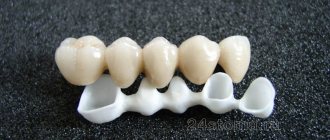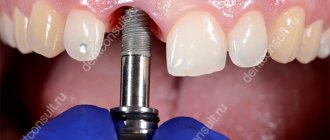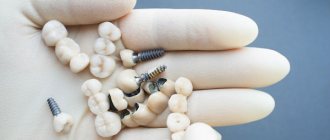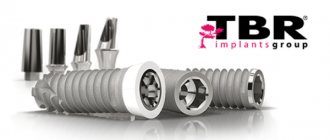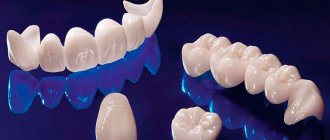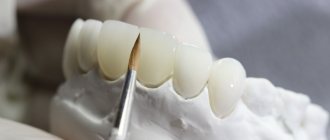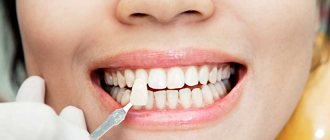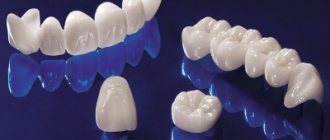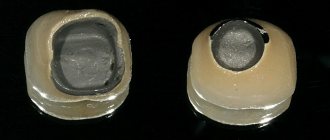2123
Modern dentistry makes it possible to solve almost any patient problem.
Implantation is one of the main branches of dentistry, which allows you to recreate lost teeth using artificial roots.
Patients are offered a wide range of different models and types of implants to choose from. One of the most popular designs are zirconium products.
General overview
The material does not cause rejection or inflammation and takes root well in the oral cavity, which is why many patients choose zirconium implants.
High-strength implants are implanted into the jaw arches in order to install a prosthesis on top that imitates natural dental crowns.
Implants made from crystalline particles of aluminum oxide are widely used in medical practice and have their own characteristics:
- the material is white , so it matches well with the shade of natural teeth;
- a high percentage of biocompatibility eliminates cases of material rejection by soft tissues;
- zirconium systems are often used to install dentures in the frontal area of the jaws , where the central incisors and canines are usually located; this process is carried out in order to visually hide the implants, because the metal can be visible through the gums.
The doctor plans future prosthetics together with the patient and advises which implants are best to use depending on the clinical situation.
Zirconium structures are usually implanted in the following circumstances:
- if it is necessary to restore a large group of teeth;
- when reconstructing one unit;
- if there are contraindications to other methods of tooth reconstruction;
- if it is necessary to install a bridge structure.
Implantation using materials made from zirconium chips is prescribed by an implantologist, based on the collected medical history data.
Advantages of using Harvest Smartprep technology for dental implantation.
Go here to learn about the benefits of using 3D navigation for dental implants.
At this address https://www.vash-dentist.ru/implantatsiya/metodiki/aspektyi-kompressionnoy-zubov.html you will find all the most important things about compression dental implantation.
What are zirconium implants and why did they appear?
M.D.:
First of all, it must be said that a dental implant is the best alternative when a person has lost a tooth. Nothing better has been invented to date. They are trying to do something like that - growing teeth from a rudiment, etc., but growing teeth is a technology that is still at a very early stage. How and when growing teeth in humans will appear clinically and will be available to patients is difficult to even imagine.
Dental implantation is developing very rapidly, since there are no alternatives to implantation as such. And for a very long time, since Branemark began producing titanium implants, the whole world has been installing and installing titanium implants.
For reference:
Titanium is one of the chemically active metals, but it has high corrosion resistance, since a stable passive film of TiO2 is formed on its surface, firmly bonded to the base metal and excluding its direct contact with the corrosive environment. The thickness of this film usually reaches 5–6 nm.
Thanks to the oxide film, titanium and its alloys do not corrode in the atmosphere, in fresh and sea water, and are resistant to cavitation corrosion and stress corrosion, as well as acids of organic origin.
M.D.:
Alloys changed, since titanium itself in its pure form is a very bioenergetic, very good metal, but it is quite soft, and for this reason certain titanium alloys began to appear. And since the strength of the implants increased, but at the same time in order for this strength to appear, various other metals began to be added to titanium, and alloyed titanium was made for implantation. And patients began to develop problems, such as the body’s autoimmune response, which can be immediate or very delayed. And sensitization can take years, months, and it can develop very progressively, gradually.
What to do for such patients who have an allergic status
, and is this allergic status to titanium, or to those various additives with which titanium was ligated? There was no alternative until metal-free zirconium implants appeared.
Zirconium implants appeared not so long ago, about 15 years ago
, and they had a very difficult development, because zirconium is very difficult to process and it is resistant to acids, it is difficult to process.
Zirconium
is a very high-tech material. Not every company could bear this burden and develop the production of high-quality zirconium implants. It’s good that companies have emerged that have overcome numerous problems and are now producing truly the best zirconium implants. By the way, in appearance, unlike titanium dental implants, they look like completely white implants, see photo:
Yu.K.:
What are zirconium implants made of? Made of zirconium, like zirconium crowns? Because people, you know, when the first thing that comes up on the Internet using the word zirconium, they immediately pick up zirconium crowns; so far only a few people know about dental implants and even write about them.
M.U.:
Absolutely right. Yes, it is made from zirconium, more precisely zirconium dioxide - stabilized zirconium.
The advantage of zirconium dioxide is that it is a super-hard material. The strength of zirconium dioxide is higher than that of titanium, so it has confidently found its place in dentistry. And, for example, the dental implants that we use are made using a unique technology, that is, it is an all-zirconium monolithic implant, with the lower part made of only zirconium, and the upper part of the implant smoothly transitions into softer zirconium. And this is also the uniqueness of zirconium implants.
Yu.K.:
It turns out that this is such a premium segment? Since we use such high-tech materials, then, accordingly, this is no longer a mass market, not a mass market?
M.U:
Of course, the manufacture of zirconium implants is many times more difficult than the manufacture of a titanium implant, since now, with the presence of chip machines and technologies, they are advancing very much, and what was previously quite difficult to make and mill and make from titanium has now become quite simple.
And due to the fact that these unique technologies and the complexity of processing, the complexity of working with this zirconium dioxide in general - this, of course, imposes an additional financial component.
Indications and contraindications
Before implanting artificial material, it is necessary to familiarize yourself with the indications for surgical intervention and contraindications.
Indications for the implantation of zirconium implants are formed on the basis of individual data on the patient’s health status:
- with partial absence of dental crowns;
- if the patient is allergic to medical metal alloys;
- to restore the central group of teeth on the upper and lower jaw arch;
- if the patient has tissue damage from periodontal disease;
- in case of bite defects and the impossibility of using other implantation methods.
Implantation is strictly contraindicated if the patient has general or chronic diseases of the following types:
- venereal diseases;
- endocrine disorders;
- inflammation of various types on the mucous membranes of the oral cavity;
- blood diseases;
- oncological diseases;
- tuberculosis;
- connective tissue diseases (rheumatic disorders, scleroderma);
- bruxism;
- mental dysfunctions;
- the presence of addictions in a neglected state (alcoholism, drug addiction).
When installing implants, there are acceptable phases of diseases that are not absolute contraindications: osteoporosis, a certain form of diabetes.
Before surgery, it is necessary to treat or remove teeth if you have the following oral diseases:
- inflammation of gum tissue and gum pockets;
- carious lesions;
- initial stage of periodontitis.
Also, dental elements should not be implanted in pregnant women , persons with deep malocclusion and atrophic changes in bone tissue.
Advantages and disadvantages
Dentists call the advantages of zirconium rods:
- structural strength;
- biocompatibility of the material;
- aesthetics;
- service life reaches 15 years or more;
- implants do not “sit down” even after 10-15 years.
Disadvantages include high cost and insufficient knowledge of the properties of the material.
Installation algorithm
Implantation is carried out in stages:
Diagnostics. After an initial examination and medical history, the doctor prescribes X-ray and computed tomography scans. Urine and blood tests and biochemistry are considered mandatory.
Sanitation of the oral cavity. This stage includes professional teeth cleaning, removal of damaged units and treatment of dental diseases that prevent the immediate start of implantation. This stage is important because after surgery the risk of developing inflammatory processes and suppuration is reduced.
Anesthesia. Surgery is performed under local anesthesia. Before administering the anesthetic, the anesthesiologist clarifies the presence of contraindications to the use of the drug. The dosage is calculated based on the patient’s individual parameters (age, height, weight).
Implantation process. Before proceeding with surgery, the doctor simulates a computer version of implantation. At the appointed time, according to the drawn up plan, the operation is carried out:
- dissection of the gums;
- drilling the jaw bone;
- antiseptic treatment;
- screwing the implant into a previously prepared hole.
After fixing the structure, the gum is sutured.
Rehabilitation
Osseointegration takes place under the close attention of the dentist. While the wound is healing, the doctor prescribes antibiotic therapy. If necessary, it is recommended to relieve pain symptoms with anesthetics. In order not to disturb the position of the implant, you need to exclude solid foods from your diet. Regular teeth cleaning and visits to the dentist are the key to successful and rapid osseointegration.
Complications
| Click to sign up for a FREE consultation |
Implantation of an artificial root is a complex surgical procedure, and the absence of complications cannot be guaranteed. Moreover, the properties of zirconium dioxide have not been 100% studied.
You should pay attention to the experience and qualifications of the attending physician, since inexperience entails violation of the rules of the operation and, as a result, body hyperthermia, chills, severe toothache and headache.
Osseointegration usually lasts 3-6 months and occurs with a feeling of mild pain in the implantation area.
Advantages and disadvantages
Zirconium implants have undeniable advantages compared to other medical designs:
- high rates of restoration of aesthetic proportions of the smile;
- the design is quite strong and durable in use;
- high biocompatibility of the material practically eliminates the risk of inflammation and complications;
- the strength of the initial installation of the structure allows you to place a load on the implants almost immediately after implantation;
- the root part has a light shade and does not show through the gums, which allows it to remain invisible when installing an artificial crown;
- zirconium material can be implanted even with signs of periodontal disease;
- shrinkage of the implanted implant is completely eliminated, even during long-term use;
- the antimicrobial properties of zirconium exclude the development of caries and suppuration;
- materials that do not contain metal do not interfere with the natural viability of bone tissue;
- zirconium has low thermal conductivity, which means that the patient will not feel any discomfort when eating hot food;
- The warranty period for zirconium materials is quite long - at least 15 years.
However, even a high-quality system has its drawbacks:
- the properties of the material have not been fully studied, because zirconium implants are an innovation in prosthetics;
- the price of the structures is quite high.
In addition, it is worth understanding that even the positive properties of the implanted material will not affect the correction of deep bite.
The nuances of dental implantation for hepatitis C and the main stages of the operation.
In this publication, read about zygomatic dental implantation.
Here https://www.vash-dentist.ru/implantatsiya/metodiki/mozhno-li-delat-mrt-s-zubov.html let’s find out together whether it is possible to do an MRI with dental implants.
Key disadvantages of zirconium crowns –
Despite the above advantages, zirconium crowns also have equally important disadvantages, which cast doubt on the advisability of their use in the area of central teeth (especially in patients with a high level of transparency of tooth enamel).
1) They are not suitable for front teeth -
Most dentists will praise the aesthetics of this type of crown, but in reality there are many complaints from patients about them. Crowns and veneers made of zirconium dioxide are not suitable for anterior teeth due to the lack of transparency of the zirconium frame, as well as due to a significantly smaller selection of shades of color (compared to E-max). All this increases the risk that artificial crowns and veneers will not blend in with neighboring teeth in color and transparency.
Pay attention to the lack of transparency and the unnatural milky color of the crowns (Fig. 20-22). Be prepared for the fact that if you decide to get zirconium crowns on your front teeth, they may not look very natural...
The use of opaque zirconium dioxide blocks (usually also bright white) results in the finished crowns being an unnatural milky color. Therefore, if you want perfect aesthetics, it is better to give preference to IPS Emax. If you are still set on zirconium crowns, then you will have to sweat a little, finding out the manufacturer of zirconium dioxide blocks in each clinic (we have given the rating of manufacturers at the end of the article).
Trying on finished zirconium crowns – video 3-4
Video 3 clearly shows that the crowns on the four front upper teeth are milky in color and do not at all match the color of the patient’s own teeth. It must be stated that if you want to make yourself zirconium crowns, in 90% of all cases they will look exactly like this - artificial and unnatural. In video 4 , the crowns have a more natural color and shape, but unfortunately the patient will now forever have black triangles in the interdental spaces (since the gingival papillae will never be able to fill the interdental spaces).
2) Chips of ceramics –
The problem of chipping is typical for zirconium crowns lined with a layer of porcelain on the outside. Despite the very high strength of the zirconium frame itself, more than 900 MPa (megapascals), the strength of the connection between the porcelain layer and the zirconium frame is only about 100 MPa. This is the point of vulnerability of zirconium crowns, which are not as strong as they are advertised.
Thus, the cause of chipping is a rather weak connection between the zirconium frame and the surface layer of porcelain. This is why many dentists do not recommend making porcelain-lined zirconium crowns in the area of chewing teeth. According to statistics, chips of the surface layer of porcelain of zirconium crowns are observed in 6% of patients after 3 years, and in 10% of patients after 5 years of use.
For example, when using metal-ceramic crowns over 10 years of observation, chips occur in only 10% of patients (which is 2 times less likely than with zirconium crowns). And chipping occurs even less often when using IPS E-max pressed porcelain ceramic crowns. A way out of this situation may be to manufacture monolithic zirconium crowns on the chewing teeth that do not have a surface layer of porcelain. But at the same time, the absence of porcelain will naturally worsen the aesthetics.
3) Abrasion of antagonist teeth –
Zirconium dioxide is a very durable material that is not subject to abrasion. Therefore, friction against the zirconium crowns of antagonist teeth can, in some cases, lead to an acceleration of the physiological wear of these teeth. Accordingly, periodic inspections are necessary to detect this problem in time.
However, in any case, this type of crown should be used with extreme caution in patients susceptible to increased tooth wear. In this case, crowns are usually placed on the antagonist teeth on the other jaw.
Installation steps
Implants are installed only after consultation and collection of diagnostic data.
The stages of preparation and conduct of surgical intervention have a certain sequence and are clearly formed by specialists.
Consultation and diagnostics
Before surgical operations, consultation and complete collection of information about the patient’s health condition takes place:
- information about general diseases of the body;
- condition of the oral cavity: presence of dental lesions, condition of gums, bone tissue and correct bite;
- the indications and contraindications for the intervention are assessed;
- Inspection of the condition of the jaw arches allows the specialist to correctly select the type of implant.
The doctor conducts a detailed consultation and consults with the patient, assessing his capabilities. After diagnosis, the specialist predicts the course of the procedure and the desired result.
Sanitation
The second stage of mandatory preparation for implantation is sanitation of the oral cavity, which involves a set of health measures:
- treatment of affected teeth is performed;
- professional cleaning of the oral cavity is carried out;
- If necessary, soft tissue treatment is performed.
Sanitation is aimed at cleaning the jaw arches and teeth from unwanted deposits before performing surgical procedures.
The procedure is carried out in order to completely exclude the entry of unwanted bacteria that provoke suppuration.
Thus, the postoperative period passes without complications, and the implant takes root faster.
Anesthesia
A prerequisite for surgical intervention in the bone tissue of the jaw arch is the presence of anesthesia. The dosage is selected individually by the anesthesiologist.
Features of this procedure:
- the anesthesiologist collects data on the patient’s contraindications to the administration of anesthesia: the presence of allergic reactions to drugs, general diseases;
- local anesthesia is used for implantation;
- The operation is canceled if there are contraindications; in such cases, other treatment methods are selected.
Before administering an injection for local anesthesia, the specialist calculates the dosage of the drug depending on the weight, age and height of the patient.
Implantation process
The implantation procedure will be performed only by a professional surgeon using high-quality medical equipment and materials: a special drill and a custom-made implant.
The surgical procedure itself is simulated using computerized technology and then performed on the appointed day:
- the surgeon makes a dissection of the gum in order to expose the required area of bone tissue;
- then the bone material is drilled and a hole is prepared for implantation of the material;
- after antiseptic treatment, an implant is implanted into the drilled hole;
- the last stage is suturing the gums at the site of the initial incision.
At the stage of implantation of the structure, it is very important to observe all necessary measures for disinfecting instruments, materials and the patient’s oral cavity itself.
Is it possible to put zirconium crowns on implants?
Zirconium crowns are among those structures that do not contain metals, so they can be considered almost an ideal option for prosthetics. In addition to excellent aesthetic indicators, they also have other advantages, in particular:
- Zirconium dioxide is durable and can withstand maximum load during the chewing process;
- the material is absolutely harmless, does not lead to allergic reactions and does not cause irritation to the mucous membrane;
- zirconium is completely biologically compatible with the human body;
- low thermal conductivity of zirconium protects the patient from exposure to cold and hot substances;
- resistance to color changes and external influences.
Based on all this, the only conclusion that arises is that it is certainly possible to place such crowns on implants. Moreover, regardless of how many teeth are missing and what treatment protocol is used. For example, zirconia bridges can be anchored in partially edentulous cases, as well as in full tooth restorations using techniques such as all-on-4 (4-by-4 dental implantation), all-on-6, and similar immediate loading protocols.
Rehabilitation period
The period of osseointegration must be carried out under the supervision of a physician, and the patient must strictly follow all medical recommendations:
- a course of antibiotics is required;
- painkillers are taken until the discomfort is eliminated;
- avoid traumatic foods;
- thoroughly and carefully clean dentures and the oral cavity as a whole;
- Visit a doctor for an x-ray of the jaw arches.
Visiting a doctor during the rehabilitation period is mandatory within the first month.
If complications, severe discomfort, or excessive weakness occur, you should immediately contact a specialist.
In cases of positive osseointegration, the patient visits the dentist initially once every three months, then once every six months.
How are zirconium dioxide crowns made?
A zirconium dioxide crown for implants is milled from a single crystal, and then a thin layer of porcelain enamel is applied to it, the color of which is selected as close as possible to the natural color of the patient's teeth. And if you have large voids in the jaw or complete edentia, you can choose the color of your new teeth you want and get a real Hollywood smile.
To make a zirconium crown, an impression of the patient's jaw is first taken, and then a CAD/CAM program is used to scan it and create a virtual 3D model of it. After which the program designs the ideal shape for the patient for new crowns, their installation locations and the angle of inclination.
The prosthesis is then cut out on a machine connected to a computer. For such a crown, an individual abutment is often made, which is similar to a natural tooth ground for a crown and takes into account the anatomical characteristics of a particular patient.
Possible complications
The postoperative period is not always easy, and implantation of the material can cause complications, so it is very important to have the intervention performed only by a certified specialist:
- incomplete study of zirconium oxide in action suggests that there cannot be an exact guarantee of the absence of complications;
- mistakes made during the operation can cause fever, chills, severe headaches and toothaches;
- It is impossible to remove the implant because irreversible osseointegration processes occur in the bone tissue.
The implant takes a long time to heal (from 4 to 6 months), all this time the jaws “get used” to the new material, and the patient may feel discomfort and toothache.
A visit to a specialist during this period is necessary for the patient himself to eliminate the risks of complications.
The video provides an overview of the design of a zirconium implant.
What it is?
These structures are made of durable zirconium oxide. It is 100% compatible with human jaw bone. Most often they are recommended for patients prone to painful perception of foreign body implantation.
Among the advantages, there is one particularly important one - implants have a white color, which is as close as possible to the shade of natural human teeth. Most often they are used to restore the anterior dentition, which is visible during conversation. The disadvantage of their titanium competitors is that at certain angles and brightness of lighting, the pin can be visible through the crown, which cannot be said about zirconium.
Reviews
Zirconium implants are not very common in medical circles, despite the positive properties of the material.
Experts predict the durability of zirconium structures, as well as the absence of unwanted inflammation after implantation.
You can share your feedback about installing zirconium implants in the comments to this article.
If you find an error, please select a piece of text and press Ctrl+Enter.
Tags implants implantation
Did you like the article? stay tuned
Previous article
Subtleties of using the Bio Gide membrane for bone grafting
Next article
Why is it better to install braces on 2 jaws?
Indications for installation
STARTSMILE: In what cases is implantation with zirconium systems recommended?
Dakhkilgov M. U:
Zirconium dental implants can be used in any clinical cases. Patients with sensitivity to titanium need them most, when that same unwanted immune response occurs. Previously, if a reaction to titanium was detected after the test, implantation was denied. Today we offer installation of zirconium implants. So far, no allergic reactions to zirconium have been recorded in any patient.
Dakhkilgov M. U:
Another indication is low quality or lack of bone tissue. In such non-ideal conditions, zirconium takes root faster, and in some cases allows you to do without osteoplastic procedures. Zirconium oxide implants are also in high demand among those who need impeccable whiteness to restore their front teeth. They are suitable for both single installations and total implantation, when the dentition is destroyed or completely absent.
STARTSMILE:Are there any contraindications? Let’s say a person has diabetes mellitus or another systemic disease, are such patients turned away or undergoing implantation surgery?
Dakhkilgov M. U:
There are few contraindications. Most often these are serious diseases, such as oncology, tuberculosis, blood diseases, mental dysfunction, etc. As for diabetes mellitus or, for example, osteoporosis, these diseases have acceptable phases that are not absolute contraindications. Our centers help such patients, but only after diagnostic measures. All risks must be eliminated.
Make an appointment
right now!
Dakhkilgov Magomed Umatgireevich
Surgeon, Implantologist
Manufacturing process
The crown manufacturing process uses high-precision equipment and consists of several stages:
- Manufacturing frame from zirconium dioxide. To do this, they use a computer model made on the basis of casts and a special 3D modeling program.
The principle of operation is as follows: a laser beam reads the shape of the impression and transmits it to a computer, where the program itself models the future crown taking into account the received data.The base is machined from a single piece of zirconium on a special milling machine. The entire process takes place in a fully automated mode under computer control.
This allows you to eliminate errors in the formation of the required frame geometry. After turning, the product undergoes shrinkage under pressure and high temperature.
- Coating the base with ceramics .
The ceramic mass is applied to the frame by spraying, layer by layer. Each layer undergoes a sintering process carried out under pressure. This increases the mechanical adhesion between the two materials based on compressive stress and surface synthesis. After applying the last layer, the surface of the product is treated. To do this, it is turned, ground and polished.
We invite you to look at the computer modeling process in this video:
Flaws
Compared to such a large list of advantages of such a material, zirconium implants have some disadvantages:
- high cost of the product, because it is a rare chemical element that is difficult to obtain;
- The effect of zirconium compounds on the human body has not yet been fully studied, so it is impossible to say with 100% certainty what their presence in the bone and soft tissues of the maxillofacial area can lead to.
In addition, there are a small number of contraindications for their use:
- prohibited during pregnancy, because anesthesia is not allowed;
- bruxism (night grinding of teeth);
- large depth of bite;
- diabetes mellitus of any type or HIV infection, which in principle is a limitation for any type of standard implantation;
- pulpitis;
- degeneration of bone tissue in the area of future implantation;
- caries (will need treatment first);
- gingivitis and stomatitis.
